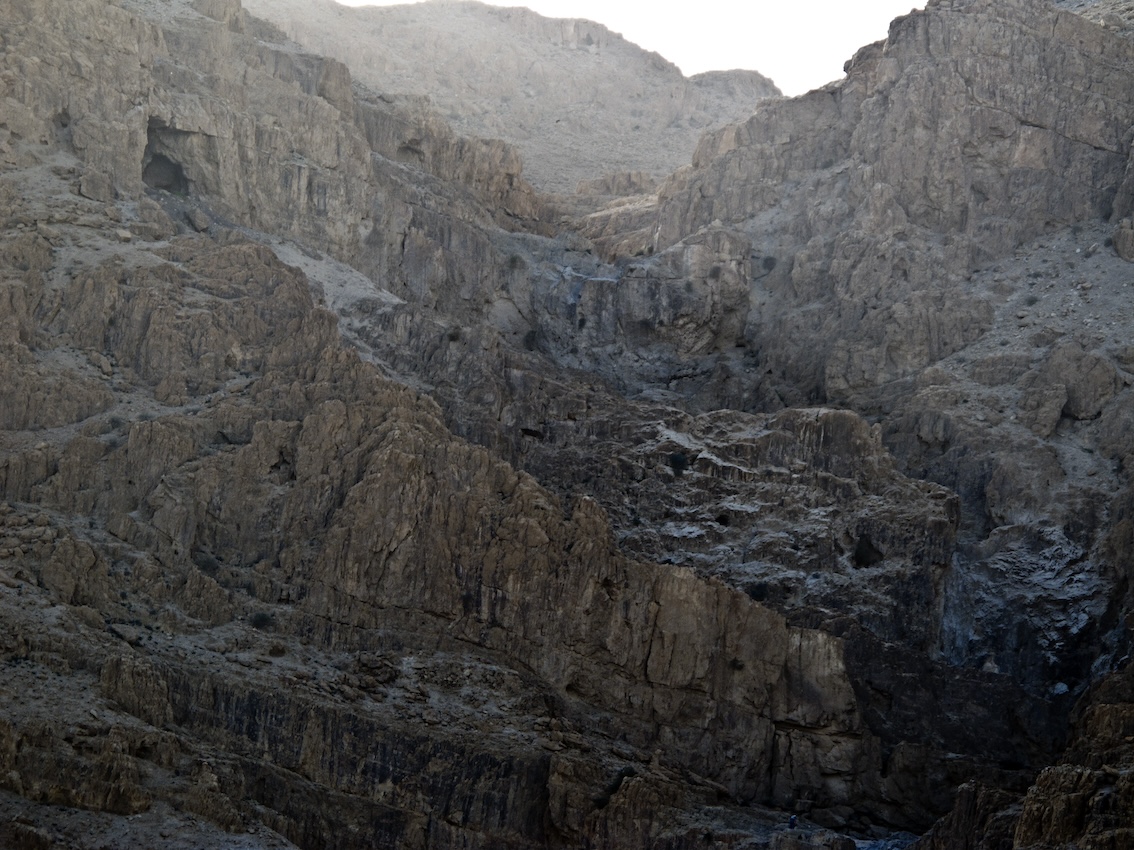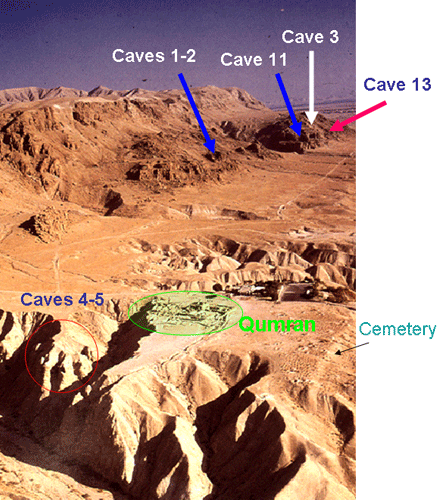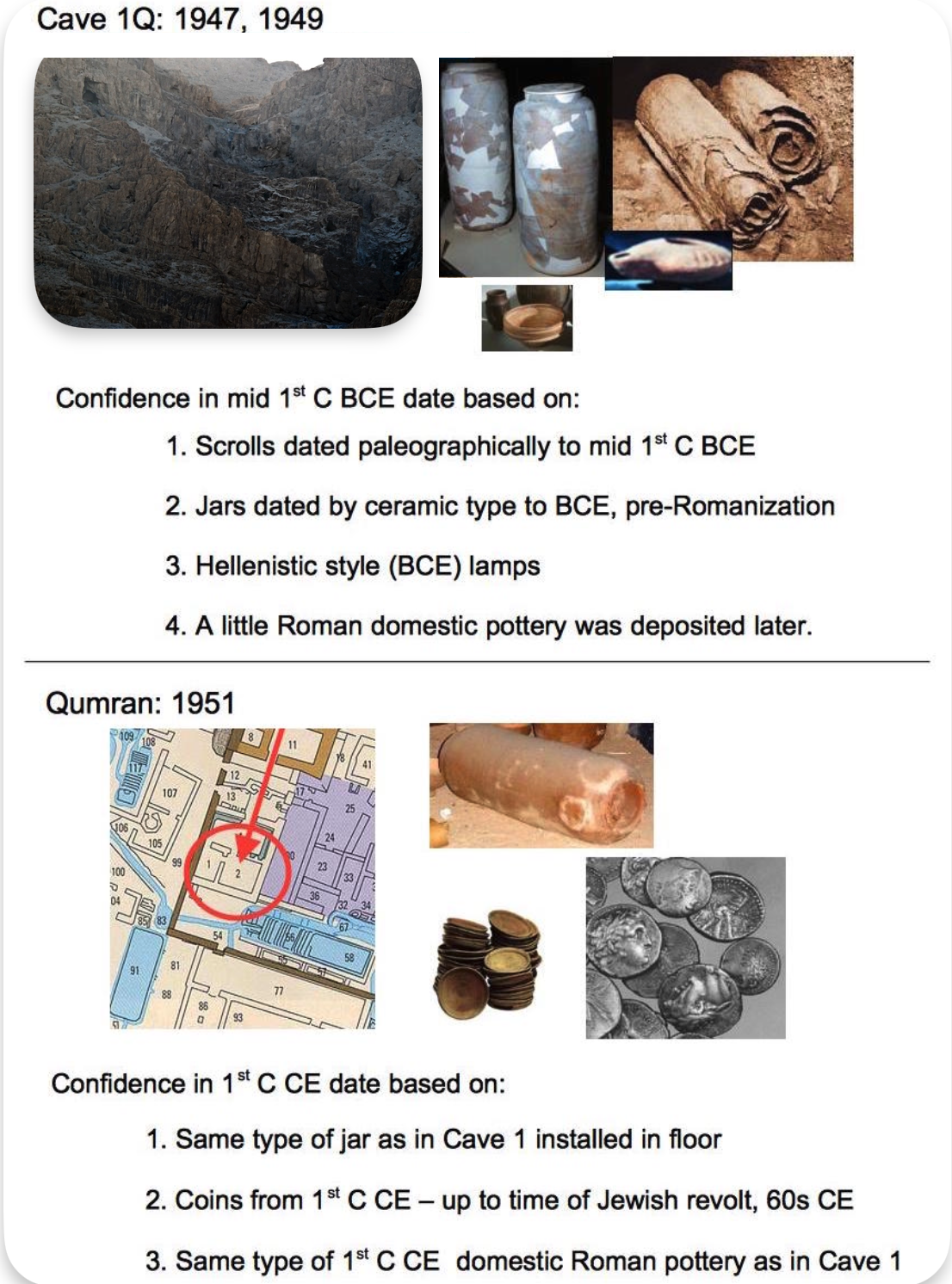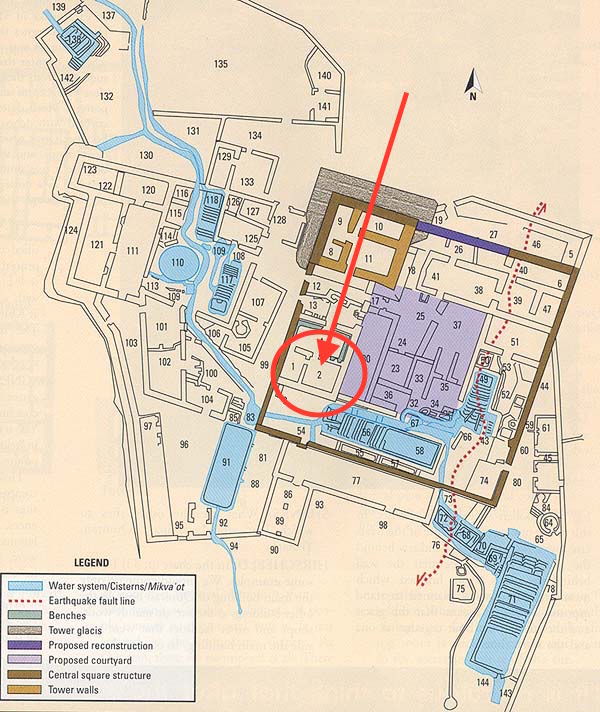Previous posts in this series:
For this post I am returning to Gregory Doudna’s 2014 conference paper, Dating the Scroll Deposits of the Qumran Caves: A Question of Evidence.
In the 1990s Doudna raised the question of whether the Qumran cave scrolls had been deposited as late as the first century CE. This was the first time since the excavation of the Qumran settlement in 1951 that the question had been raised.
In this post I want to attempt to set out Doudna’s explanation of how dating the scrolls went (in his view) so wrong.
.
1947 – Discovery and the first dating
When the scrolls were first discovered they were dated by Solomon Birnbaum and William F. Albright to the mid first century BCE.
This period was based on palaeographic analysis of the script.

.
1949 – the first dating confirmed
Cave 1 was excavated in 1949 and Albright dated jars and lamps associated with the scrolls before the second half of the reign of Herod when “Romanization” influences began to dominate. Since Herod ruled 37 to 4 BC that places the pottery before ca 20 BCE.
Dating this time was based upon ceramic typology. Items assessed were “scroll jars” and two “hellenistic” lamps.


There was a small quantity of later Roman domestic pottery and lamps but this was regarded by all as “intrusive and later, not associated with the scrolls and scroll jars.”
Albright’s conclusion:
We may rest assured . . . not a single piece [fragment of scroll] found in the cave is later than the early years of the Herodian Age at latest. (Albright, W.F. 1950. “The Dead Sea Scrolls of St. Mark’s Monastery,” BASOR, 118: 6)
.
1951, Nov-Dec. – Excavation of the Qumran “settlement”
The Qumran “settlement” is a little over 1 km south of Cave 1.

The term “settlement” is misleading since it implies a permanent domestic habitation. As we have seen in the previous two posts there are very good reasons for understanding occupation of Qumran was seasonal and that it was generally deserted every summer.
But the significant point for this post is that with the excavation of 1951 the dating of the scrolls changed dramatically.
A jar identical to the one found in Cave 1 was found embedded in the floor of “Locus 2” of Qumran. Locus 2? For those who are as finicky as I am and want a clear grasp of the details here is a map I located from somewhere(?): I have highlighted what looks to me like Locus 2 —
Other pottery in the same room was identical to the domestic pottery in Cave 1. Recall that that domestic pottery in Cave 1 had originally been regarded as “intrusive”, later than the scrolls and scroll jars and lamps there.
Coins dated to the first century CE up to time of the Jewish revolt 66-70 CE were also found in Locus 2 and nearby loci.
It followed (so it seemed) that the scroll jars and scroll deposits of Cave 1Q were first century CE. (Doudna, p. 240)
For someone like me who is very new to this discussion I find it helpful to set it out graphically:
 The conclusions drawn from the Qumran 1951 excavation trumped the previous BCE conclusions. The palaeographic datings had been assessed to be BCE but the archaeological evidence appeared to put those behind the eight ball.
The conclusions drawn from the Qumran 1951 excavation trumped the previous BCE conclusions. The palaeographic datings had been assessed to be BCE but the archaeological evidence appeared to put those behind the eight ball.
Excavation of the settlement at Khirbet Qumran has established beyond doubt that all of the material was deposited in these caves in the late first century AD. (Harding, G.L. 1955. “Introductory, the Discovery, the Excavation, Minor Finds,” in Qumran Cave 1 (DJD 1; ed. D. Barthélemy and J. T. Milik; Oxford: Clarendon Press, 4)
Albright and others fell in line with the new chronology.
.
Recalibrating the palaeography to fit
So what of the contradictory (earlier) dates based on palaeography?
The typologically most developed formal hands among the Qumran texts were redefined with later dates than previously published, ending at the time of the First Revolt. (Doudna, p. 240)
Frank Moore Cross, Jr. revised the stages of progression of the types of scripts, assigning to each typology its own date range, so that the scrolls from Cave 1 ended at the time of the Jewish Revolt in the mid/late 60s CE.

Other types of script had since been discovered further south at Wadi Murabba’at. These new scripts were far advanced over the Qumran texts and bore similarities with the much later Masoretic Text. Since the Qumran text was now said to fill out the first century CE up to the time of the Jewish War, the Murabba’at texts were consequently dated after the destruction of Jerusalem in 70 CE.
This culminated in Cross’s well known study of 1961 which has been the standard used for palaeographic dating ever since.11 On this basis all of the non-Qumran biblical scrolls then known (from Wadi Murabbaʿat and Naḥal Ḥever) were dated post-70 CE and their scribal hands named “post-Herodian formal,” in Cross’s 1961 reconstruction.12
11 Frank M. Cross, “The Oldest Manuscripts from Qumran” JBL 74 (1955): 147–72; idem, “The Development of the Jewish Scripts,” in The Bible and the Ancient Near East: Essays in Honor of William Foxwell Albright (ed. G. E. Wright; Garden City, NY: Doubleday, 1961), 133–202.
12 Cross, “The Development of the Jewish Scripts,” 174, 199, n. 136a.
(Doudna, p. 240)
So the palaeographic typology that in the 1940s assigned the cave texts to BCE was after 1951 and the excavation of Qumran shifted to CE and up to the Jewish War.
Doudna emphasises the point:
To repeat and to be clear: the focus on the First Revolt as the date of the latest Qumran texts began as an archaeological correction in the dating of the scroll jars and scroll deposits in the caves. Then the palaeographic datings were secondarily adjusted to be in alignment. That was the specific direction of the logic. The archaeological correction of the scroll deposits to the First Revolt was the basis for fixing the palaeographic dates of the latest Qumran cave texts to the first century CE, and the dates of the biblical texts postdating the Qumran caves’ latest to later than 70 CE. (p. 240)
Sounds simple enough? But not so fast.
That resetting of the palaeographic dates to conform with artefacts in Qumran was based on three assumptions, all of which were “deeply flawed.”
.
To be continued. . . . .
If you enjoyed this post, please consider donating to Vridar. Thanks!


Sir, you are using my photo from Cave 1, which is published on the website of the IAA without my permission? Why don‘t you pay attention to the copyright rules?
Alexander Schick
http://Www.bibelausstellung.de
You are quite correct and I do apologize. I like to think I have had a reasonably careful record with respect to rights issues with any images I post here but clearly my merely linking to the source of the image was not appropriate in this instance, especially when that page has now gone defunct. I have replaced your photo with a Creative Commons one.